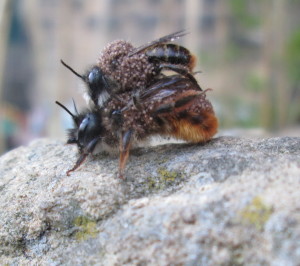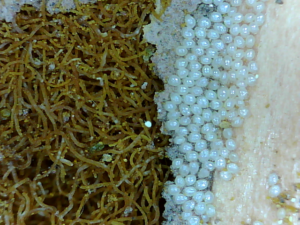PLEASE clean your Red Mason bee (Osmia bicornis) cocoons!
Pollen mites attach themselves to the bees using huge claws as they leave their natal nest, hitch a lift, (phoresy), and transfer to a female during mating hitching a lift back on their new host to drop off inside a new nest cavity. Once inside the safe environment of a red mason bee’s cell, they breed and can soon become many thousands inside one cell, outcompeting the bee larvae for food, reducing the size or even starving them to death. For the bee larvae, it is a race against time. According to some researchers, they may also eat the egg before it hatches and even certain later stages of larval development.

Pollen mites pass from one Red mason bee to the other during courtship. Probably leading to the death of her offspring
To cater to environmental factors within the cell, probably food scarcity or decreasing humidity, they have developed a survival strategy. Some become migratory mites and migrate as described, waiting till spring when the bee leaves its cell or as it passes through a mite-infested cell, often found in huge numbers that it can affect the flight of the bee.
A new film with new research Pollen Mites (Chaetodactylus osmiae)
The remaining mites, encyst and are non-migratory. They remain in situ inside your solitary bee nest until some environmental cue triggers their activity. It’s a survival strategy that works as they can remain dormant during unfavourable conditions for several years.

Encysted pollen mite bidding their time inside a Red Mason bee nest next to Cacoxenus indagator frass
Your ‘bee hotel’ nest may well contain many 1000’s of both types of mite later in the year. These methods enable them to maintain their normal host relationship and disperse to gain new hosts. Cleaning your bee cocoons greatly reduces the mites and definitely helps your bees to survive and increase in numbers. And we all want that now do n’t we!
Nest to nest dispersal
Other than those that hitch a lift on a bee, mites will also disperse within solitary bee nests by walking to nearby nest entrance holes, walking from nest to nest through splits, cracks, holes, gaps and parasitic wasp emergence holes, all of which can be found in wood, straws, canes, reeds, paper/cardboard tubes.
For more information about the solitary bee, pests see Beware! Is your ‘bee hotel’ a nursery for disease and pests?
With thanks to Simon Caxton for the above photograph and Werner David for mites on cardboard tubes
For more information about solitary bees and wasps visit BWARS
Interested in Citizen Science and pollinators? (e.g. bees!) The Buzz Club

Recent Comments